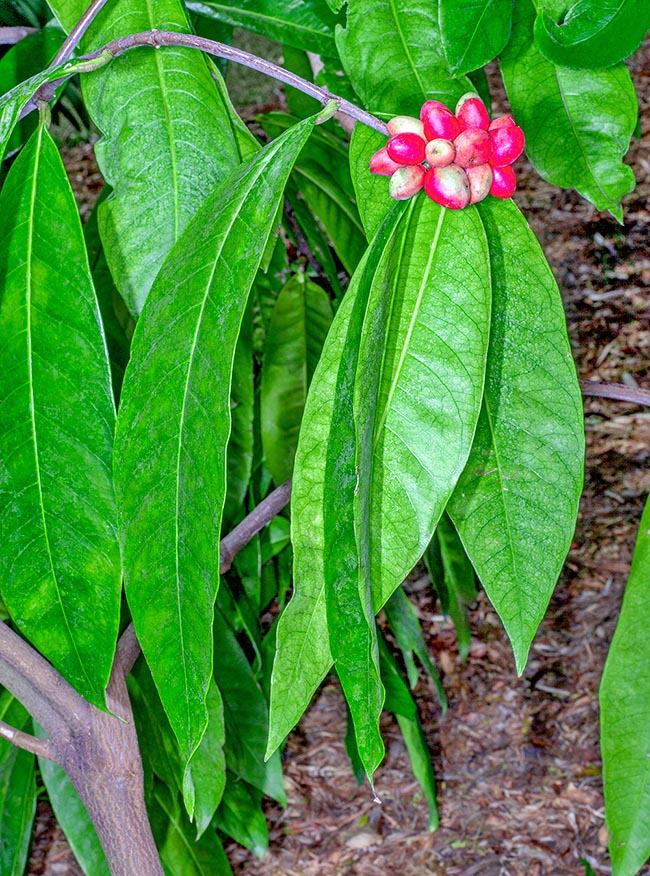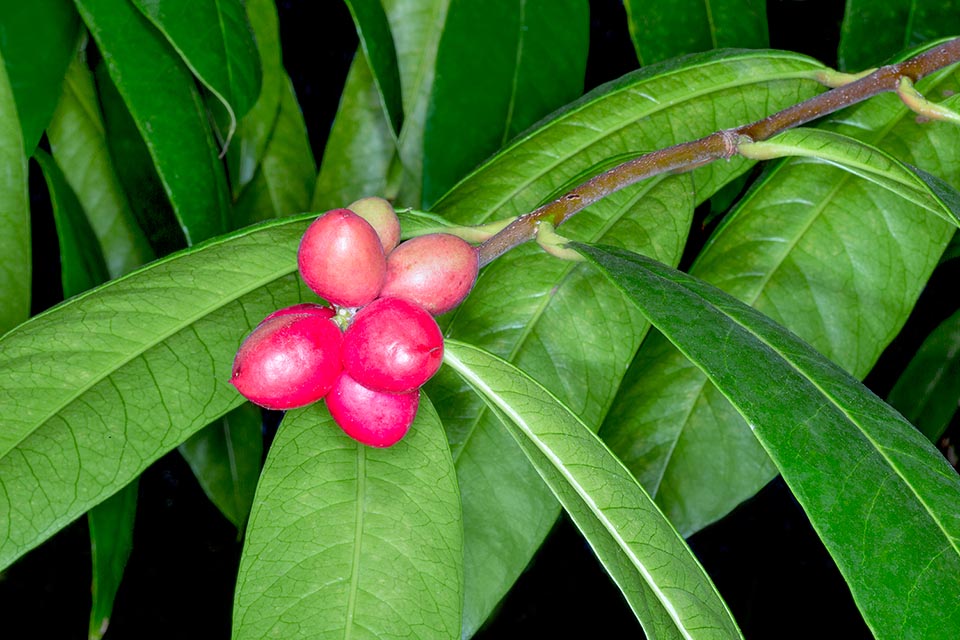Family : Thymelaeaceae

Text © Pietro Puccio

English translation by Mario Beltramini

Phaleria octandra is a shrub or small tree native to Australia and South East Asia reaching the 6 m of height © Giuseppe Mazza
The species is native to Australia (Northern Territory and Queensland), Java, Lesser Sunda Islands, Moluccas, New Guinea and Sulawesi where it grows in the under-wood of the pluvial forests, from the sea level up to about 800 m of altitude.
The generic name comes from the Greek “φαληρος” (phaleros) = luminous white, with reference to the colour of the flowers: the specific name is the combination of the Greek substantives “ὀκτώ” (octό) = eight and “ἀνήρ, ἀνδρός” (aner, andrόs) = male, man, with reference to the numbers of the stamens.
Common names: cape daphne, dwarf phaleria (English).
The Phaleria octandra (L.) Baill. (1875) is a shrub or a small erect evergreen tree, up to 6 m tall, but that in cultivation usually does not exceed the 2 m, with branches at times falling and coarse bark of brown colour.
The leaves, on a 0,5-1,5 cm long petiole, are alternate below, opposite above, simple, elliptic to oblong-lanceolate with entire margin and acuminate apex, 7-22 cm long and 3-8 cm broad, coriaceous, of glossy green colour.
Terminal inflorescences, less frequently sub-terminal, corymbose, on a 0,3-0,8 cm long peduncle, bearing 6-18 apetalous sessile flowers, of white or white suffused of yellow colour that with the time tend to darken.
Hypocrateriform calyx, slightly pubescent externally, with thin tube, 0,8-2 cm long, and 4-6 ovate lobes with rounded apex, retroflexed, 0,5-0,8 cm long, 8 prominent stamens arranged in two verticils and little longer style.
Ovoid fruits, 1-2 cm long, and of 1-1,8 cm of diameter, initially of green colour, then glossy red when ripe, containing 1-2 seeds immersed in a fibrous pulp.
It reproduces by seed in draining organic loam maintained humid at the temperature of 25-28 °C with germination times of some days and first blooming starting from the 4 years of age.
Due to its intensely perfumed flowers united in compact inflorescences and the showy fruits, it is at times utilized in the tropical and subtropical gardens, not bearing temperatures close to the 0 °C, in the shade of big trees. It is not particular about the type of soil, provided porous and draining and maintained almost constantly humid.

It is often cultivated in the tropical gardens, where rarely exceeds the 2 m of height, for the scented flowers and the showy fruits. Elsewhere, in the warm temperate climates, can grow also in big pots that however must be sheltered in winter in bright spaces, where lowest temperatures never go under the 16 °C © Giuseppe Mazza
Elsewhere it may be cultivated in pot, in organic loam with the addition of siliceous sand or agri-perlite per a 30 %, to be sheltered in the coldest months in luminous environment, with lowest temperatures not under the 16 °C. The watering must be regular during the vegetative period, more spaced in winter, but without ever allowing the loam to dry up completely, and the fertilizations, in spring-summer, to be done with a balanced hydro-soluble product with micro-elements.
Synonyms: Phaleria laurifolia (Decne.) Thwaites ex Hook. f. (1869); Phaleria blumei var. latifolia Benth. (1873); Phaleria neumannii (F. Muell.) Benth. (1873); Phaleria ambigua (Meisn.) Hook. f. (1896); Phaleria longifolia (Miq.) Boerl. (1900); Phaleria laurifolia var. javanica Valeton (1913); Phaleria pedunculata C.T. White (1919); Phaleria octandra var. laurifolia (Decne.) Warb. ex Malm (1934); Phaleria parvifolia Backer (1942).
→ To appreciate the biodiversity within the THYMELAEACEAE family please click here.
